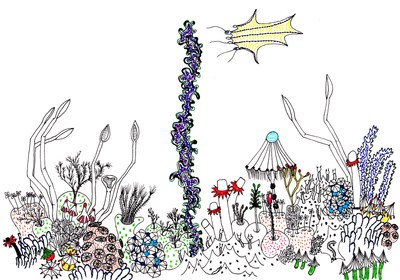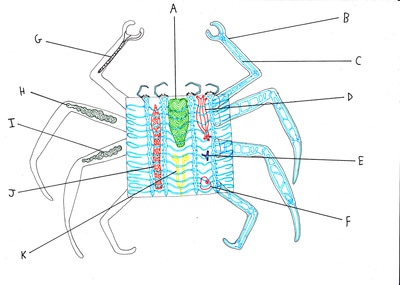|
There are many seed world concepts in speculative biology projects. Serina is a world populated by guppies and canaries introduced from Earth. Kaimere is populated by many Earth lineages introduced over long periods of time. Much more exotic, the Mammalian Ectoparasite Seed World (MESW) by Twisting Depths is a world of ticks, mites, fleas, flies, and lice. Some have grown to monster sizes and include cuddly blade-faced predators, grass-eaters, and shark-like organisms. Check them out.
2 Comments
Katie is the creator of four worlds: Xenosulia, Amthalassa, Nemoros, and Eurus. Each has its own blog out in the internet wilderness (Amthalassa shares its blog with stories of a British garden). The posts are in the order of most recent articles on the top, so you’ll want to go to the bottom to read about the climate, biochemistry, and anatomy of the major clades. Later posts cover specific biomes and genera.
Amthalassa is a world of ammonia, methane, and hydrogen. In deserts, moss fixes its own nitrogen to create ammonia to keep from drying out. Soft-stemmed kelp-like “trees” fill their bladders with hydrogen to support their weight in the thick atmosphere. Smaller plants crawl very slowly from place to place. Animals are radially symmetrical, with one eye per leg, a ventral mouth, and a dorsal tail containing an anus and genitals. Many are saucer-shaped. Others are snake-like with their legs clustered around the mouth. Still others have become bilaterally symmetrical, but retaining one eye per leg. There are herbivores and carnivores. There are shells, spines, and feathers. There are floating grazers that hold symbiotic, hydrogen-containing plants. There are eyes with inner and outer lenses able to move relative to each other. It’s a beautiful place. Xenosulia is a tidally-locked world of acid rain and air algae. Trees are bilaterally symmetrical to better face the unmoving sun. Land animals sift algae from the air with the equivalent of baleen. Others are predators or grazers. The dominant animals are descended from radially symmetrical ancestors, with mouth and genitals on top surrounded by a compound eye ring and the anus on the bottom at the end of a tail. In most lineages, there are two front limbs and the anal tail has become a third limb for hopping. Skeletons are silica, nerves operate on triggered bioluminescence, muscle cells shrink by bonding gas from bubbles into specialized proteins, and many animals carry their haploid offspring as symbiotes. Wings are supported by blood vessels, spines provide thermoregulation (and more), and jaws evolved several times in different ways. The biodiversity is filled-out, with vaguely sloth-like, turtle-like, snake-like, mole-like, scorpion-like, and dromaeosaur-like forms. Another interesting lineage with potential is the “hingeflies.” Nemoros is a moon of planet Aulea. It is a world of ammonia volcanos and very cold temperatures. Methane lakes dot the icy soil. Grass-like and tree-like producers cover the landscape. The nitrogen atmosphere is thick, allowing animals to tumble along with little effort. Those with hydrogen bladders can easily swim/fly. The atmosphere is also very hazy. Chemosynthesis is more common than photosynthesis. Sonar is more common than sight. Plants take in methane and store their food as acetylene. Animals eat the plants, inhale hydrogen, and exhale methane. The dominant clade is one of tetrahedral symmetry, though most lineages have evolved various forms of radial or bilateral symmetry. The animals flower, producing larvae that fuse in pairs to produce chimerical adults. Limbs move by the opposition of contracting muscles and expanding muscles. Eurus is a low-oxygen world with an axial tilt of 87 degrees. The winds are severe. The plants resemble bamboo. The land animals are descended from molluscoids and have their anuses near their mouths. Their muscles exist inside hollow bones. Making use of bioluminescence, their nerves operate like those on Xenosulia. There are turtle-like and ferret-like forms. Smaller relatives with more legs also have wings derived from fins. |
Like alien art? Check out my store.
Copyright © 2017



 RSS Feed
RSS Feed